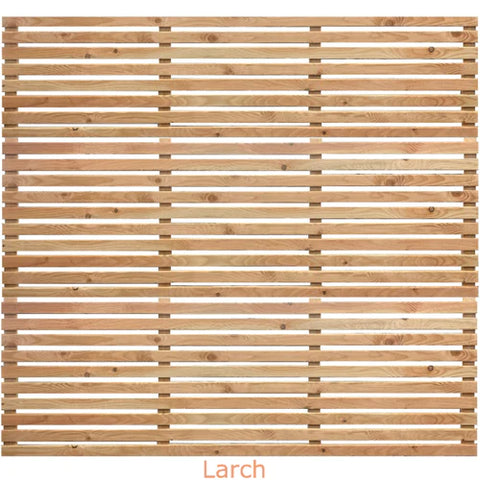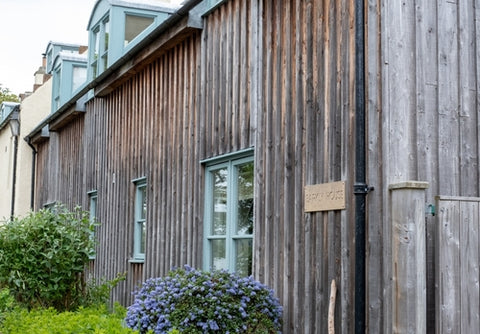
The Battle of the Timbers: Cedar or Larch
The Battle of the Timbers: Cedar or Larch
When it comes to popular timber choices, Cedar and Larch are definitely up there! Whether using as versatile cladding solutions for new builds and retrofits, slatted panels as stylish screening or stunning planters for your garden, they both have a lot to offer. Versatile and attractive, they serve up so much in terms of durability, aesthetic appeal and sustainability.
The aim of this blog is to discuss the unique properties of each. Plus to delve deeper into each species individual attributes and guide you to making an informed decision as to what best to use for your next project.
However, it’s not quite as simple as just comparing the two different wood types. There’s also the added complication of choosing where your timber comes from: Western Red Cedar versus Homegrown Cedar and Siberian Larch versus Homegrown Larch. It’s probably therefore best to start off discussing the attributes of each first.
Cedar: Homegrown or Western?
In order to do a quick and clear comparison between each, we’ve compared 5 main components - Source, Aesthetics, Durability, Sustainability and Cost.
Western Red Cedar
Below is a photo showing Western Red Cedar used as a high-end cladding option to create a stunning garden building.

Source
As the name suggests, Western Red Cedar is native to the Pacific Northwest. It’s predominantly found in the coastal regions of British Columbia, Canada and parts of the United States.
Aesthetics
The sapwood is narrow and white in colour. The heartwood is reddish-brown. With conventional high temperature kiln drying you can expect a uniform reddish-brown tone to your timber lengths. However, after long exposure to the weather, this colour fades and is replaced by silver-grey tones. Although not strictly an aesthetic, its also worth mentioning that Cedar has a lovely distinctive aroma.
Durability
Western Red Cedar is renowned for remarkable durability and decay resistance. Thus making it an ideal choice for exterior applications. The wood contains natural oils that act as preservatives, safeguarding it from insects and decay, even in damp and humid conditions.
Sustainability
This Cedar variety has gained popularity globally due to its exceptional qualities. Buyers appreciate the sustainability practices associated with harvesting from managed forests. However, the carbon footprint of transporting this timber from North America to the UK must be taken into consideration.
Cost
Western Red Cedar is by no means a cheap option. But it does give you exceptional value for money in terms of longevity.
Homegrown Cedar
Below is an example of the rich reddish - brown tones you can expect in homegrown Cedar.

Source
Homegrown Cedar refers to wood that has been grown in the UK. Often, as in the case of us here at Ruby UK, we source our homegrown Cedar from managed forests in the South-West.
Aesthetics
Homegrown Cedar shares many aesthetic qualities with Western Red Cedar. Conventional high temperature kiln drying gives it a uniform reddish-brown tone. After long-term exposure to the weather, if not oiled or stained this colour is lost and the wood becomes silvery grey. Compared to Western Red Cedar there will be numerous knots due to the fast growing nature of the species.
Durability
Like Western Red Cedar, homegrown Cedar offers excellent durability and resistance to decay. This is thanks to the natural oils and compounds that protect the wood from pests and environmental factors. However, compared to Western Red Cedar, it doesn't quite have the same high durability.
Sustainability
Using homegrown Cedar supports local economies and sustainable forestry practices within the region. It gives Architects and homeowners greater control over the sourcing process. The timber has not traveled thousands of miles across the Atlantic so is a more sustainable product.
Cost
Homegrown Cedar is much cheaper than Western Red Cedar. We would advise however, allowing 20% for wastage due to the frequency of knots along the board.
That’s all the important information covered on the two types of Cedar that we offer at Ruby UK so lets now look at Larch.
Source
As the name suggests, Siberian Larch is found in the colder Eastern European climes. Winters here are colder and longer and are crucial to producing a high density, slow grown timber. The sourcing of this timber has been greatly affected by the invasion of Ukraine by Russia. Sanctions placed on the importing of some timbers including Larch could cause supply chain issues due to risk of conflict timber status and low consumer confidence.
Aesthetics
Siberian Larch displays golden to reddish-brown tones with a straight grain pattern. Like Cedar, the wood will turn a silvery-grey colour over a period of time if left untreated. See photograph above of the walkway for an example of this.
Durability
Siberian Larch is extremely durable. Its actually 50% harder than Scots Pine and slightly stronger in terms of bending and toughness. It has a high level of resistance to rot and insects and will ensure a long-lasting solution for all external building projects.
Sustainability
Siberian Larch has traveled many miles to get to the UK. It therefore has a higher carbon footprint than homegrown. Offsetting this are reports that Siberian Larch is being replanted faster than it is being harvested. This at least, does in someway counterbalance the higher carbon footprint.
Cost
The cost of Siberian Larch is fairly high but it is slightly cheaper than Western Red Cedar. It also offers exceptional value for money due to the longevity of the timber.
Homegrown Larch
Below is an image showing our Homegrown Larch Slatted Panels. Loved by our customers for their versatility and providing stylish fencing solutions.
Source
Homegrown Larch is a natural tree of the mountains and requires really long, cold winters for its development. It would appear to need these conditions for the ripening of the wood. As we don’t get such a cold or long season in the UK - especially in the southern counties, our Homegrown Larch is generally inferior to the Siberian Larch. However, its still a very high performing timber choice.
Aesthetics
The heartwood is generally a pale reddish to brick red in colour. Therefore, homegrown Larch can have subtle pink-red tones. It’s a very resinous wood with a straight grain and fine uniform texture. As it dries rapidly however, it does have an inclination to distort and for knots to split and loosen.
Durability
Homegrown Larch is a very dense and tough timber. However, because of its quick growing properties, it is not as durable as Siberian Larch.
Sustainability
As the timber has usually been grown quite locally, it has good sustainable properties. Less distance in transporting the timber means a lower carbon footprint than it’s Eastern European counterpart. It is important to choose timber from a reputable supplier where the Larch has come from a managed forestry.
So that’s the discussion on the varieties of Cedar and Larch. Let’s now compare them overall against each other:
Above shows the contemporary look that can be achieved with Cedar cladding to give a stunning facade to a home.
Overall Comparison of Cedar Versus Larch
The below aims to give you an overall comparison of the two types of timbers. We've kept it in the same format to make it easy to see the similarities and differences.
Source
Cedar species offers the option of homegrown or sourcing from North America for Cedar. Therefore offer options for sourcing locally or from further afield. Where the species have been grown in their native countries, it seems they are a better quality of timber. For example, cold long winters in Siberia mean that the Larch here is growing slowly in its natural environment. This results in an extremely dense timber. Further proof of this statement comes from the respected organisation; Timber Development UK who report that Larch grown in Southerly Europe areas is less dense than that grown in the Eastern European countries. Larch comes in home-grown species and
Aesthetics
Both Cedar and Larch offer beautifully coloured timber. Siberan Larch is initially a yellow/golden brown colour. Homegrown Larch will probably have a more red-pink tinge to it. Cedar is a pale reddish-brown through to a dull brown initially. However, both will change over time to a silvery-grey colour. Therefore, if you don’t want this to happen, both species of timber will require you to apply a stain or paint. Osmo do a particularly good Larch or Cedar Oil that helps preserve their original colour. An important aesthetic consideration is also that the homegrown timbers of either species, will give you a more rustic look. For example, homegrown Cedar and Larch are faster growing and as such, both have a more open grain, so expect quite a few knots.
The below is a home clad in Larch which as been left to weather naturally giving a more traditional look to the building.

Durability
Both Larch and Cedar are extremely durable and resistant timbers. The native species, e.g. Siberian Larch and Western Red Cedar compared to homegrown are slower growing so offer higher levels of density and durability. Larch is the more dense timber of the two. As a comparison, Redwood Cedar when dried is 390 kg/m3 and Siberian Larch when dried is 590 kg/m3. Both species do not need treatment applied as they are extremely durable timbers. As a conclusion, if you require timber with a higher structural strength, Larch would be your choice.
Sustainability
Although, there is control through the supply chain of the timbers imported (Western Redwood Cedar and Siberian Larch) through the PEFC and FSC schemes, there is still the higher carbon footprint to take into consideration than homegrown timber. Even when sustainably sourced from certified forests in Eastern Europe or Northern America, the impact on the environment is higher. If a supplier is able to source from a locally managed forest then homegrown really does make sustainable sense.
The photograph highlights the above showing homegrown Larch at Eggesford Forest, Devon. This is just some 15 miles away from us at Ruby UK.

To sum it all up...
So there you have it. The comparison conclusion between both timbers gives anything but a clear winner.The homegrown versions of Cedar and Larch are generally a lower cost than the imported timbers. However, you must remember that you will need to allow a higher waste percentage due to the timbers having more knots and shakes. There is definitely a more rustic look to the homegrown timber.
Both materials offer unique attributes that can be used to create remarkable building exteriors and garden spaces. Aesthetically, its all about personal preference and what look you are after. Both will leave a lasting impression! If your choice is based on sustainability then the homegrown, as long as it comes from a managed forest and certified supplier is going to be your best bet. If you are after a superior looking, minimal knotted timber, then the Western Red Cedar or Siberian Larch would be a better choice.
Obviously budget will also play a part in your decision. With Western Red Cedar coming in as the most expensive, followed by Siberian Larch, you might decide the homegrown is the best option for you. This might be especially true if you are using the timber for cladding a shed where you might be happy with a more rustic look.
Therefore, lots to consider. The resounding conclusion though is that whichever you choose, Cedar or Larch, native or homegrown, you will be getting an exceptionally durable, high performing, superior building material. It’s clear that in the battle of Cedar versus Larch, there is no plain victor, they really are both timber royalty.

